MANUFACTURER'S SPECIFICATIONS:
TUNER SECTION: IHF Sensitivity: 1.8 µV.
Capture Ratio: 3.0 dB. THD (Mono): 0.5%.
Image Rejection: Better than 85 dB.
Spurious Response Rejection: 90 dB.
FM Stereo Separation: 35 dB.
AMPLIFIER SECTION:
Total IHF Music Power: 110 Watts @ 4 ohms.
RMS Power/Channel: 43 Watts @ 4 ohms.
THD: 0.5% at rated power. IM: Less than 0.5% at rated power.
Power Bandwidth: 10 to 40,000 Hz.
Frequency Response: 5 to 60,000 Hz ± 1 dB.
Hum and noise: 90 dB below full power output.
Tone Control Range: ± 12 dB Bass and Treble Boost and Cut at 50 and 10,000 Hz.
Damping Factor: 30:1.
GENERAL: Dimensions: 16 3/8" W x 4 1/4" H x 12 3/8" D.
Price: $299.95 (includes metal enclosure; walnut enclosure optional, extra).
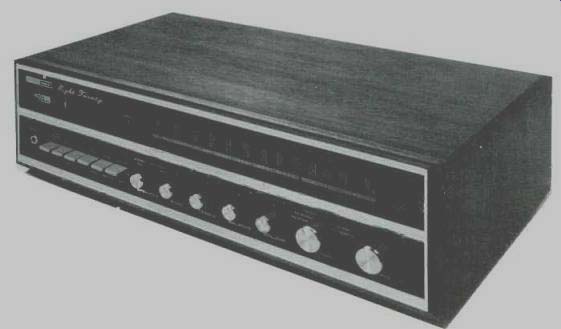
Fig. 1
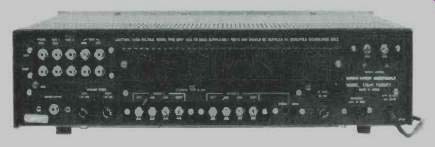
Fig. 2--Rear panel view of the 820 receiver shows neat placement of the input
and output connections.
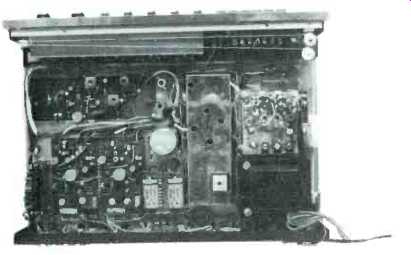
Fig. 3--Internal view of chassis, showing modular printed-circuit construction
and sealed front-end and i.f. sections.
This newest entry in Harman-Kardon's popular Nocturne range embodies the same serene styling which first attracted listeners to the series some years ago. The entire surface of the front panel is of the blackest black plastic, tastefully framed by polished gold trim with gold and black knobs to match. The upper half of the panel is totally black until power is applied, at which time it becomes softly illuminated in clear green, disclosing the FM tuning scale, a center-of-channel tuning meter and a series of indicator lights which denote signal source and the presence of a stereo FM signal.
The lower portion of the panel contains all the necessary controls as well as a stereo headphone jack at the extreme left. A series of "piano key" type switches perform secondary functions, such as tone control "defeat" (for those who would operate the receiver with absolutely flat frequency response) , FM muting on/off, high frequency filter, stereo/mono switch, and loudness (contour). Rotary controls include a speaker selector, bass (ganged for both channels) ,. treble (similarly ganged), balance, volume (including the power on/off switch), function selector switch and, finally, the tuning knob which is coupled to a very effective flywheel. Our only quarrel with this otherwise well planned control arrangement is the linking of the power on/off switch with the master volume control.
Another "piano-key" switch would have served this function better, in our view. A view of the entire front panel of the Eight-Twenty is shown in Fig. 1. Figure 2 shows the back panel layout which, besides the usual input and tape output jacks, features a center-channel output jack, well spaced terminal screws for speaker connections, speaker fuses, an overall line fuse, FM antenna terminals (300 ohm match only), and an a.c. convenience outlet. A threshold control for adjusting muting is located below the antenna terminals. A switch, adjacent to the second pair of speaker terminals, enables the user to parallel the outputs for use with a single, monophonic speaker system in a secondary location. Incidentally, when the speaker selector switch is set to "Systems 1 & 2", a series fixed resistor of 3.3 ohms is inserted in series with each amplifier output. While this cuts down on total available power to the pairs of speaker loads it prevents the inadvertent application of net loads of less than four ohms. Thus, even if two pairs of 4ohm impedance speakers are used, the impedance seen by the amplifier channel would still be 4/2+3.3 or, about 5.3 ohms. While most integrated receivers have provision for tape input, (whether it's called "Tape" or "Aux") , the Harman-Kardon Eight Twenty designers have provided two sets of inputs for tape, bowing to the new popularity of cassette playback units. The reasoning is probably that many people now own (or will own) both reel-to-reel tape recorders and the more convenient, if lower quality, cassette units. As a side benefit, the dual input availability also means that you can record from reel-to-reel units on to cassette types and vice versa-using just the Eight Twenty as your "master console". In Fig. 3 we see the top-of-the chassis layout (with the metal cover removed). Note that the front end and i.f. modules are totally shielded.
This particular i.f. circuit, by the way, requires no alignment (barring ratio-detector touch-up), since wideband crystal filters are used instead of the usual interstage transformers. Two integrated circuits do most of the amplifying and limiting in this circuit, although eight discrete devices are used as well. The front end employs four active devices, one of which is a Junction Field Effect Transistor, used for r.f. amplification.
AFC was not deemed necessary by the designers and we concur, since the front-end frequency stability was very good under voltage and temperature variations likely to be encountered in home use. Frequency calibration, by the way, was also excellent, accurate within about 100 kHz at every point on the dial. Power amplifier circuitry is transformerless and operates in the class B mode.
Measurements
In all fairness to this receiver, we were able to measure IHF sensitivity at 2.0 µV, rather than the 1.8 µV claimed. However, our measurements were taken at 98 MHz,, as prescribed by IHF. It should be noted that at 106 MHz, IHF sensitivity was a bit better than claimed, measuring 1.6 µV, while at 88 MHz, the figure was 2.3 µV. These minor variations could, no doubt, be balanced out by more careful alignment, but all three figures are well within production tolerances. This specification, as well as other primary FM performance criteria, is graphically illustrated in Fig. 4. We wonder why published specifications did not include maximum FM S/N, since the measured value was an excellent 70 dB! 1 dB limiting took place at an input signal of only 2µV while total harmonic distortion measured 0.5%, as claimed. In stereo, however, this THD figure rose to 0.8%, still a highly acceptable figure.
Stereo FM separation is plotted in Fig. 5 and meets published specifications at midband. At the high end, separation drops to about 20 dB at 10 kHz, while the low end maintains a 30 dB separation capability all the way down to about 80 Hz.
We were sorry to see Harman Kardon join the "±1 dB" power rating which has been editorially decried by this and other publications. Playing this numbers game, HK comes up with a power rating (total) of 140 watts, although they do publish a 11-watt IHF rating, albeit at 4-ohm load impedance. The r.m.s. per channel power rating of 43 watts was taken from a product listing in the September 1969 issue of Audio, as supplied by the manufacturer and is also based upon a 4-ohm load. In keeping with our usual practice, all measurements were made at 8 ohms, and the THD and IM characteristics obtained are plotted in Fig. 6. On this basis, 1% THD was evident with a power output of 30 watts per channel, with both channels driven. This is a perfectly acceptable power rating for a receiver in this price class, but is a far cry from the meaningless "140 watts ± 1 dB" which this manufacturer claims it must publish because "competitors started it." Power bandwidth extends from 15 to 40,000 Hz, based upon a 30watt per channel (r.m.s.) power rating, as can be seen in Fig. 7. Tone-control range, high-filter characteristic and loudness contour action are all plotted in Fig. 8, while squarewave response at 100 Hz and 10,000 Hz is pictured in Fig. 9. The photos were taken with the tone controls defeated, since they did have a degrading influence on the square wave or transient response when observed on the oscilloscope.
Listening Tests
If one had to rate the tuner and amplifier sections of the Harman Kardon Eight Twenty separately, the tuner section would come out ahead.
Just about as sensitive as any FM tuner we have tested, some 46 stations were received acceptably in our admittedly good listening location.
Sixteen of these were received in stereo. Muting was excellent. When set to maximum mute (by means of the rear control), signals having a strength greater than 10 microvolts were able to overcome the mute, and the transition from mute to "no-mute" was not accompanied by any increase in distortion. The station was either "all there" or "not there at all," as it should be. The center-of-channel tuning meter was accurate in all cases, indicating perfect detector alignment.
While the stereo indicating light had a tendency to be a bit dim when we were tuned to weaker stations, this did not affect reception or stereo separation perceptibly. In all, FM reception and stereo FM reception ranked with the best of present-day receivers.
As for the amplifier, it has sufficient reserve power to drive any low efficiency pair of speakers, but if you plan to use two pairs of speakers in two locations simultaneously, they should he of the medium or high efficiency variety. The high-cut filter is of minimal slope and hence not any more useful than the ordinary tone controls. Transients were well defined, more so when the tone controls were out of the circuit. Controls are easy to use and certainly, visually, this receiver fits in very well with our decor.
For that matter, its styling is so elegant, that it would fit in well with almost anyone's furnishings. By eliminating AM from this receiver, Harmon-Kardon was obviously intent upon producing as much receiver as possible for under $300.00. In this they have succeeded.
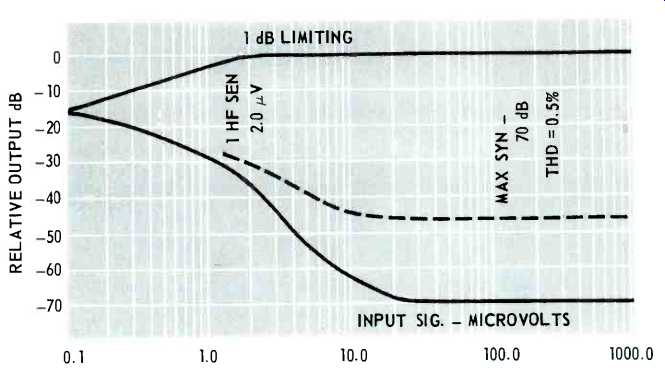
Fig. 4-FM characteristics of the 820 receiver.
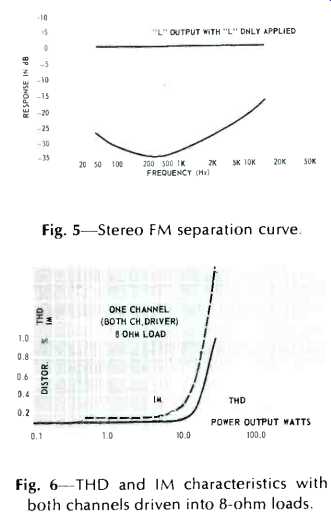
Fig. 5--Stereo FM separation curve. Fig. 6--THD and IM characteristics with both
channels driven into 8ohm loads.

Fig. 7--Power-bandwidth curves. Insets show squarewave performance at 100 and
10khz.
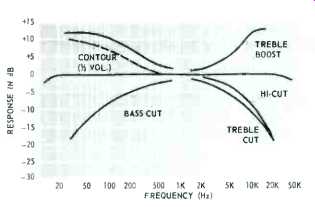
Fig. 8--Tone-control range, filter response, and loudness contour characteristics
of the 820 receiver.
(Audio magazine, Feb. 1970)
Also see:
Harman-Kardon Model 930 AM/FM Stereo Receiver (Jun. 1972)
Harman-Kardon Model 900+ AM/FM Multichannel Receiver (Equip. Profile, May 1974)
Harman/Kardon Rabco ST-7 Turntable (Jan. 1977)
= = = =